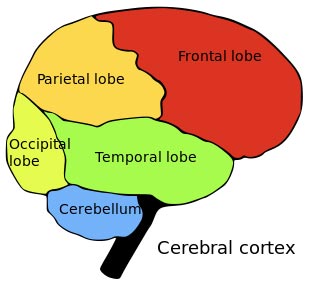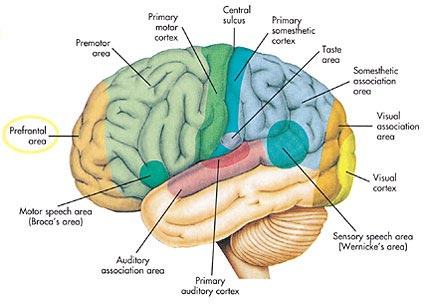Last update : October 11, 2014

brain regions
The brain is the center of the nervous system in all vertebrate and most invertebrate animals. From a philosophical point of view, what makes the brain special in comparison to other organs is that it forms the physical structure that generates the mind. Through much of history, the mind was thought to be separate from the brain. Even for present-day neuroscience, the mechanisms by which human brain activity gives rise to consciousness and thought remain very challenging to understand: despite rapid scientific progress, much about how the human brain works remains a mystery. The operations of individual brain cells are now understood in considerable detail, but the way they cooperate in ensembles of millions has been very difficult to decipher.
The human brain has three main parts :
- The cerebrum, or telencephalon (Grosshirn, cerveau), that fills up most of the skull, is involved in cognition and also controls movement.
- The cerebellum, or little brain (Kleinhirn, cervelet), that sits at the back of the head, under the cerebrum, controls coordination and balance.
- The brainstem (Hirnstamm, tronc cérébral), that sits beneath the cerebrum in front of the cerebellum, connects the brain to the spinal cord and controls automatic functions such as breathing, digestion, heart rate and blood pressure.
The human brain is divided into right and left halves (hemispheres). The left half controls movement on the body’s right side. The right half controls the body’s left side. In most people, the language area is mainly on the left. Preserved brains have a grey color, hence the name grey matter.
The brain’s wrinkled surface is a specialized outer layer of the cerebrum, called the cerebral cortex (what we see when we look at the brain). Each bump on the surface of the human brain is known as a gyrus, while each groove is known as a sulcus.
In a typical human the cerebral cortex is estimated to contain 15–33 billion neurons, each connected by synapses to several thousand other neurons. These neurons communicate with one another by means of long protoplasmic fibers called axons, which carry trains of signal pulses called action potentials to distant parts of the brain or body targeting specific recipient cells..
Traditionally the cerebral cortex is divided into four sections, which are known as lobes :
| english | latin | deutsch | français |
| Frontal Lobe | Lobus frontalis | Stirnlappen | lobe frontal |
| Parietal lobe | Lobus parietalis | Scheitellappen | lobe pariétal |
| Temporal lobe | Lobus temporalis | Schläfenlappen | lobe temporal |
| Occipital lobe | Lobus occipitalis | Hinterhauptlappen | lobe occipital |
The Terminologia Anatomica (TA), the international standard on human anatomic terminology, developed by the Federative Committee on Anatomical Terminology (FCAT) and the International Federation of Associations of Anatomists (IFAA), released in 1998, defines two additional lobes : The limbic lobe, associated to emotion and memory and the insular cortex, associated to pain and some other senses.
The frontal lobe is associated with reasoning, motor skills, higher level cognition, and expressive language. The parietal lobe is associated with processing tactile sensory information such as pressure, touch, and pain. The temporal lobe is the location of the primary auditory cortex, which is important for interpreting sounds and the language we hear. The hippocampus is also located in the temporal lobe, which is why this portion of the brain is heavily associated with the formation of memories. The occipital lobe is associated with interpreting visual stimuli and information. The primary visual cortex, which receives and interprets information from the retinas of the eyes, is located in the occipital lobe.
The cerebral cortex is also segmented in cortical areas which are functionally or anatomically defined. Some examples are listed below :
- 52 Broadman areas (BA1 – BA52)
- 6 visual cortex areas (V1 – V6)
- Sensory cortex (BA1 – BA3)
- Primary motor cortex (BA4)
- Brocas motor speech area
- Wernickes speech area
- Auditory cortex (BA41-BA42)

brain areas
The brainstem is comprised of the hindbrain (rhombencephalon) and midbrain. The hindbrain contains structures including medulla oblongata, the pons and the reticular formation.
The limbic system contains glands which help relay emotions. Many hormonal responses that the body generates are initiated in this area. The limbic system includes the amygdala, hippocampus, hypothalamus and thalamus.
Great progresses in the analysis which parts of the brain are involved in a particular mental process have been made in the last years with the functional magnetic resonance imaging (fMRI).
More informations about human brain parts and regions are available at the following links:
at Wikipedia :
- List of regions in the human brain
- Brodmann areas
- List of topics related to brain mapping
- Brain Mapping Foundation
- Brain Maps
- Brain Mapping
- Functional specialization
- Human Connectome Project
other sources :
- How your brain works, by Jan Schnupp
- The anatomy of the brain, about.com
- Interactive multiresolution next-generation brain atlas, brainmaps.org
- Portal to neuroanatomical information, Braininfo
- Functional Brain Mapping Lab, Neuroscience Center Geneva
- Allen Brain Atlas, Allen Institute for Brain Science (see report by Hayley Crawford : World’s biggest human brain map unveiled)
- Scientists develop a new brain map, Machines like us
- TheHumanBrain.Info, Uni Düsseldorf
- Human Connectome Project
- The CONNECT Consortium
- BrainFacts.org
- Memory Implants, MIT Technology Review
- Structural and functional organisation of the brain, Forschungszentrum Jülisch
- Brain-Maps.com,
- brainmap.org, Research Imaging Institute at the University of Texas
- Organization for Human Brain Mapping (OHBM)
- Brainmapping.org, Mark S.Cohen, University of California
- Comparative Neuroanatomy and Intelligence, Serendip Studio
- Cortical Architecture Imaging and Discovery Laboratory (CAID), University of Georgia
- The astonishing maps that reveal how our brain organises everything we see, by Damien Gayle, Dailymail UK
- Freesurfer, set of automated tools for reconstruction of the brain’s cortical surface from structural MRI data, Laboratory for Computational Neuroimaging, Martinos Center for Biomedical Imaging
- Brain Anatomy, Princeton Brain & Spine Care
- How to grow a better brain, Oracle Thinkquest
